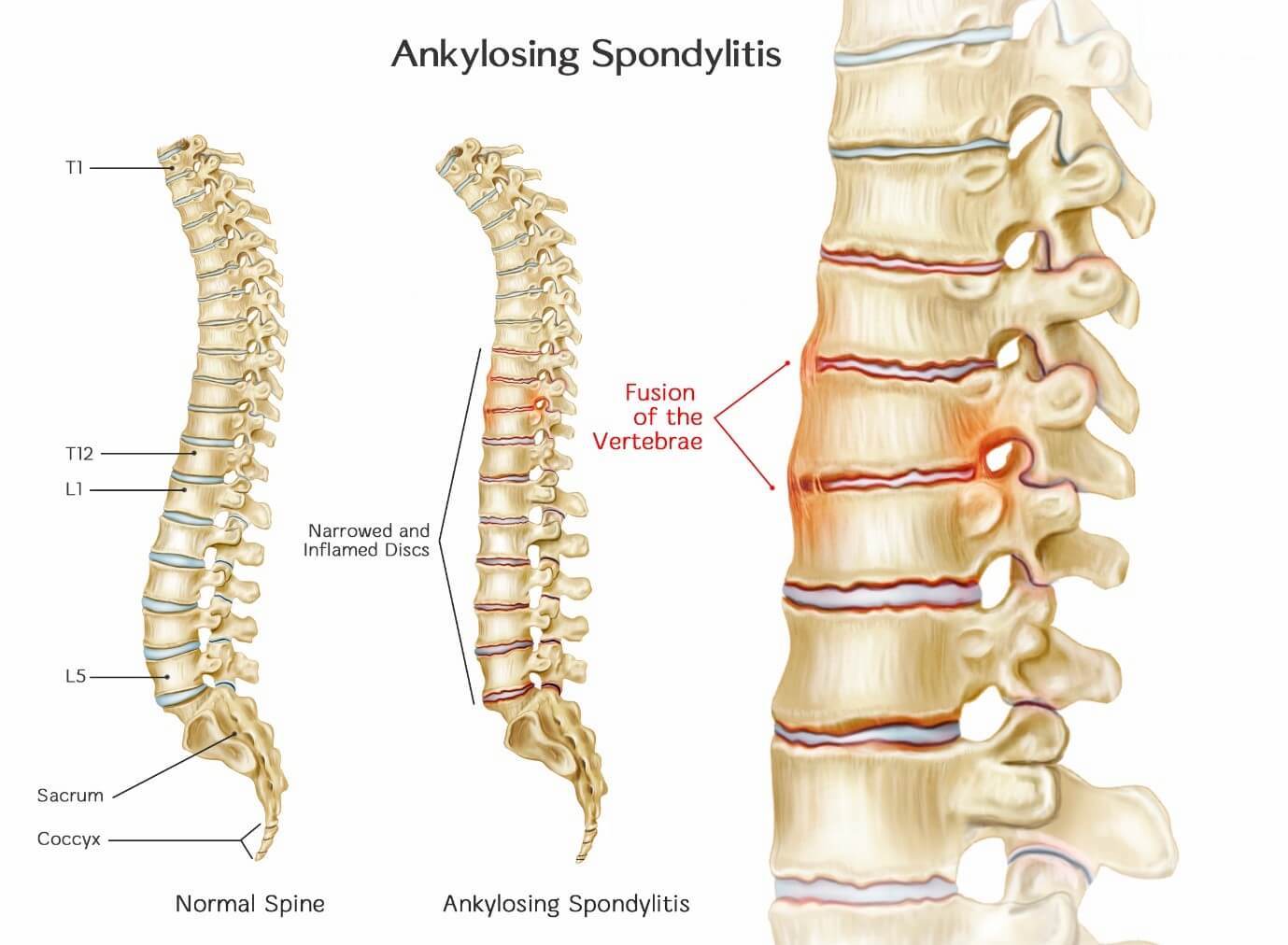In today’s life, people are suffering from various lifestyle problems and developing diseases. Diseases like ankylosing spondylitis are very familiar, specially between the age of 17 to 35 and sometimes it does appear in elder people also. Lack of necessary movements, stiff working positions and sedentary lifestyle accelerate the chances. The main causes are known to be hereditary also.


What is ankylosing spondylitis? It is a spinal disorder; basically it’s a type of arthritis that affects the whole back through inflammation. The meaning of ankylosing is rigid or stiff, the meaning of spondyl is the “spine”. The swelling in the large joints and pain in the spine causes pain as well as stiffness at the back. Spondylitis results in depletion in the gap within the hip bones and spine. Known as sacroiliac joint, the pain is often severe.
What are the causes of Ankylosing Spondylitis? The cause behind the ankylosing spondylitis is not identified, but according to the researchers, there are active role of genes. HLA-B27, a gene found in over 95% of Caucasian-Americans ankylosing Spondylitis but only 50% of people are there in African-Americans who are suffering from spondylitis. However, there are various people that gene but still don’t have ankylosing spondylitis.
Who can suffer from ankylosing spondylitis? Ankylosing spondylitisis a very common disease between the age of 17 to 35 and sometimes it can be found in elders also. Spondylitis can affect women as well as men and it can also appear in any member of the family.
What are the signs of ankylosing spondylitis? Signs of Ankylosing Spondylitis go away plus return over time. Signs can happen a bit separately in each person. The signs may involve:
- Early morning stiffness
- Straight and stiff spine
- Appetite loss
- Fatigue
- Anemia
- Mild eye inflammation
- Skin rashes
- Back pain, normally most difficult at night while resting
- Stooped position in rejoinder to back pain
- Weakness in taking breathing, if the joints between the spine and ribs are affected
- Weight loss
- Fever
- Joint pain
- Organ damage, such as to the heart, lungs, and eyes
- Gastrointestinal illness
How is Ankylosing Spondylitis diagnosed? The procedure of Ankylosing Spondylitis is begun with the medical history of the patient as well as a physical exam. Test of the patient may be done like
- X-ray. This analysis utilizes a small volume of radiation to produce pictures of bones, internal tissues, and organs on analysis projecture.
- Erythrocyte sedimentation rate. This test examines how instantly the red blood cells of the patient falls to the bottom of a test tube. When inflammation happens, the blood’s protein clumps collectively, become more complex than normal. They fall very actively at the bottom of the test tube. The quicker the blood cells drop, the more stringent the inflammation. More than 70% of people with ankylosing spondylitis have a high Erythrocyte sedimentation rate.
- Genetic testing. Genetic testing is performed to determine if a person takes a copy of an altered gene for disease because the gene like HLA-B27 is found in more than 95% of people with AS.
How is Ankylosing Spondylitis treated? Treatment of AS will depend on the signs, age, plus general health of the patient. Plus the condition of the person is also important to treat. The purpose of medication is to reduce the pain in the spine and stiffness, limit deformities, plus also keep as healthy a lifestyle as possible. Medication may involve:
- To lessen the inflammation as well as the pain in the spine, Non-steroidal anti-inflammatory medications are used
- Tumour-necrosis-factor blockers are utilized to diminish swelling
- Disease-modifying anti-rheumatic drugs like sulfasalazine are used, to reduce swelling and control ankylosing spondylitis
- Short-term utilization of corticosteroids, to lessen inflammation
- Short-term treatment of tissue relaxants plus pain relievers, to alleviate severe muscle spasms and pain
- Surgery to substitute a joint, remove parts of the thickened or insert rods in the spine, and hardened bone
- Keeping of proper position
- Daily exercise, exercises that carry strengthen back muscles
What are the difficulties of ankylosing spondylitis? As time passes, a frontal spine may develop with ankylosing spondylitis. A person who is suffering from AS has a high chance of weakening of their bones. Spondylitis can also show the symptoms of psoriasis, as well as the inflammation of the eye, intestinal tract and aortic valve.
When/How to consult a doctor? If you find any above signs hinting at chances of AS in you, then take advice from your healthcare provider. It is always better to know the exact problems to be able to start precautionary measures or relief procedures at the easliest. Talk to the health care providers regarding the uncertainties, advantages, and potential side effects of all vaccinations and medication.
